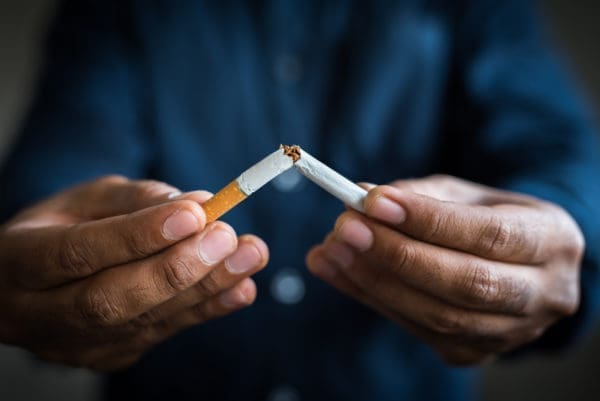It’s now nearly impossible for someone to not know that smoking is harmful. The warning labels on packages, the successful anti-smoking campaigns, the lessons in basic health classes on its negative impacts, the rise in workplace prevention programs and the sharp downtrend in social acceptance has made the message crystal clear. This guide breaks down what happens when you quit smoking to help you stay focused on giving it up.
Key facts about quitting smoking
From whatever angle you look at it— cost, health effects, inconvenience, social stigma—smoking simply isn’t worth it. In some countries, governments have mandated pictures on every cigarette carton that demonstrate that long term effects have cigarette smoking. Let’s just say that they are less than pretty.
But quitting smoking is tough. It’s not just a physical habit; it’s a psychological habit as well. For many, smoking becomes as part of their daily lives as much as breathing, eating and sleeping. With the right tools and support, you can successfully stop smoking long-term.

It’s much easier to endure the side effects of quitting smoking if you understand them. Although you may feel strong cravings to smoke again, it’s essential to know the benefits of quitting that start as soon as 20 minutes after your last cigarette. These facts might just save your life.
The first 3 days
In just 3 days of not smoking, your body can undergo serious health improvements. Here are some of the changes that occur:
Day 1-2:
- 20 minutes: Your blood pressure and pulse rate return to normal. The temperature of your hands and feet also goes back to normal.
- 8 hours: Nicotine and carbon monoxide levels decrease by 50%. In smokers, carbon monoxide takes the place of oxygen, depriving your muscles, tissues and other vitally important organs the essential nutrients its needs. As these chemicals decrease, your body’s circulatory system function improves.
- By this stage, cravings may begin. This is normal. Cravings typically last approximately 10 minutes. When you’re faced with cravings, try to distract yourself by watching TV, exercising, reading a book or getting outside for fresh air. Remind yourself that those who smoke are twice as likely to have a heart attack.
- 12 hours: Carbon monoxide decreases to normal levels further improving heart function.
- 24 hours: Your risk of heart attacks drops significantly.
Day 3:
After 48 hours, you’ve hit a significant milestone. Congratulations – your body has completely eliminated nicotine from your system! Now your senses of taste and smell will improve as damaged nerve endings start to regrow and heal. You may experience significant coughing as your body is trying to rid itself of the extra mucus in your lung. But you’ll also notice that your breathing and respiratory function are greatly improving and any instances of shortness of breath are decreasing.
At this point, strong withdrawal symptoms and cravings may begin. This is one of the toughest stages. Nicotine withdrawal effects may include:
- tiredness
- hunger
- irritability
- headaches
- even depression
This is the key phase you have to break through. Do whatever you can to distract yourself- go out to a movie, visit a friend, try yoga or another fitness class, take a walk or ask friends for support.
You may also decide to reach out for professional support. The National Cancer Institute’s quitline is 1-800-44U-QUIT. You can also chat live with one of the trained experts there as you work through this hard stage.
Here’s What Happens When You Quit Smoking
From weeks to years: how your health improves
Once you’ve made it through the first couple of weeks, you’ll start to notice a huge range of different health benefits. Your cravings will generally subside and staying away from smoking will get easier and easier.


- 2 weeks to 3 months: You’ll notice improved respiratory and circulatory function. Your risk of heart attack continues to decrease. Withdrawal symptoms decline, but you may still face occasional cravings. Be sure to stick to your quitting regimen.
- 3 to 9 months: With each month, you’ll be able to breath better and better. On average, “lung capacity rises by 39%” at this point. You may still cough occasionally, but that cough is productive, as it’s clearing out any remaining gunk. At this point, you may catch fewer colds and other illnesses as bacteria and viruses are less likely to become trapped in your respiratory tract.
Once you’ve hit the one year mark, you’ve accomplished a major feat. By now, your risk of a heart attack has decreased by 50%. By 5 years, your chance of stroke or cervical cancer is now equal to that of a nonsmoker. Likewise, your risk of developing other cancers such as the throat, mouth and bladder has decreased.
After 10 years, your chances of pancreatic and larynx cancer significantly decrease. And, compared to a current smoker, you’re 50% less likely to die of lung cancer. At 15 years, your body has recovered significantly. Your risk of heart disease is now equal to someone who has never smoked.
Your long-term health: quitting for good
Nobody has ever said quitting smoking is easy. This is a choice you make and a journey you can endure so that you can live the life you want to. Don’t wait. The sooner you quit, the sooner your body can begin to heal.
And most importantly, don’t be afraid to ask for help. It’s all around you from your family and friends to coworkers to health professionals.
Learn more about How to stop smoking and tobacco use by watching this video from the American Heart Association:
How will you stop smoking successfully long term?
Tell us which benefits of quitting smoking you’re most looking forward to this year!




